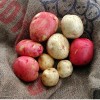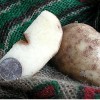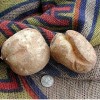
The Irish potato is a cool-season crop. A recently grown and harvested potato exhibits different flavor profiles from one that has been in storage or on a grocery shelf for an extended period. For example, in storage, the starches in potatoes convert to sugars, resulting in a less desirable texture and taste. “New” potato flavor can be achieved in the home garden by following a few growing recommendations. This is ten-page fact sheet is the Spanish language version of HS933 Growing Potatoes in the Florida Home Garden. Written by Christian T. Christensen, Joel Reyes-Cabrera, Lincoln Zotarelli, Wendy J. Dahl, Doug Gergela, Jeffery E. Pack, James M. White, and Chad M. Hutchinson.
http://edis.ifas.ufl.edu/hs1282
Tag: Chad M. Hutchinson
University of Florida Potato Variety Spot Light: Red LaSoda
 Red LaSoda is the red-skinned fresh-market potato standard for Florida. It was observed in 1949 as a deep red mutant of LaSoda in the Louisiana potato breeding program. It has been in trials over many seasons and at many locations in Florida including university and grower sites. Production and quality results provided in this 4-page fact sheet are summarized from the red-skinned fresh-market trials conducted by the University of Florida over the past 14 seasons. Written by Lincoln Zotarelli, Doug Gergela, Chad M. Hutchinson, David Dinkins, and Edsel Redden, and published by the UF Department of Horticultural Sciences, August 2013.
Red LaSoda is the red-skinned fresh-market potato standard for Florida. It was observed in 1949 as a deep red mutant of LaSoda in the Louisiana potato breeding program. It has been in trials over many seasons and at many locations in Florida including university and grower sites. Production and quality results provided in this 4-page fact sheet are summarized from the red-skinned fresh-market trials conducted by the University of Florida over the past 14 seasons. Written by Lincoln Zotarelli, Doug Gergela, Chad M. Hutchinson, David Dinkins, and Edsel Redden, and published by the UF Department of Horticultural Sciences, August 2013.
http://edis.ifas.ufl.edu/hs323
Growing Potatoes in the Florida Home Garden (HS993/HS183)
 The Irish potato is a cool-season crop. A recently grown and harvested potato exhibits different flavor profiles from one that has been in storage or on a grocery shelf for an extended period. For example, in storage, the starches in potatoes convert to sugars, resulting in a less desirable texture and taste. “New” potato flavor can be achieved in the home garden by following a few growing recommendations. This 9-page fact sheet was written by Christian T. Christensen, Libby R. Rens, Jeffrey E. Pack, Lincoln Zotarelli, Chad Hutchinson, Wendy Dahl, Doug Gergela, and James M. White, and published by the UF Department of Horticultural Sciences, April 2013.
The Irish potato is a cool-season crop. A recently grown and harvested potato exhibits different flavor profiles from one that has been in storage or on a grocery shelf for an extended period. For example, in storage, the starches in potatoes convert to sugars, resulting in a less desirable texture and taste. “New” potato flavor can be achieved in the home garden by following a few growing recommendations. This 9-page fact sheet was written by Christian T. Christensen, Libby R. Rens, Jeffrey E. Pack, Lincoln Zotarelli, Chad Hutchinson, Wendy Dahl, Doug Gergela, and James M. White, and published by the UF Department of Horticultural Sciences, April 2013.
http://edis.ifas.ufl.edu/hs183
Trastornos fisiologicos de la papa: Centro marron y Corazon hueco (HS1214)
 El centro marrón y el corazón hueco son trastornos fisiológicos internos no-infecciosos del tubérculo de la papa. Un centro marrón (también llamado corazón incipiente y hueco, corazón marrón o centro de azúcar) se caracteriza por una región muerta en las células de la médula de los tubérculos lo que resulta en un tejido de color marrón. This 3-page fact sheet was written by L. Zotarelli, C. Hutchinson, S. Byrd, D. Gergela, y D. L. Rowland, and published by the UF Department of Horticultural Sciences, January 2013.
El centro marrón y el corazón hueco son trastornos fisiológicos internos no-infecciosos del tubérculo de la papa. Un centro marrón (también llamado corazón incipiente y hueco, corazón marrón o centro de azúcar) se caracteriza por una región muerta en las células de la médula de los tubérculos lo que resulta en un tejido de color marrón. This 3-page fact sheet was written by L. Zotarelli, C. Hutchinson, S. Byrd, D. Gergela, y D. L. Rowland, and published by the UF Department of Horticultural Sciences, January 2013.
http://edis.ifas.ufl.edu/hs1214
Trastornos fisiologicos de la papa: Grietas de Crecimiento (HS1211)
 Las grietas de crecimiento son un trastorno fisiológigo externo no infeccioso del tubérculo de la papa en el que el tubérculo se agrieta durante el crecimiento. La bendidura se cura, pero deja una fisura en el tubérculo. This 3-page fact sheet was written by L. Zotarelli, C. Hutchinson, S. Byrd, D. Gergela, y D. L. Rowland, and published by the UF Department of Horticultural Sciences, January 2013.
Las grietas de crecimiento son un trastorno fisiológigo externo no infeccioso del tubérculo de la papa en el que el tubérculo se agrieta durante el crecimiento. La bendidura se cura, pero deja una fisura en el tubérculo. This 3-page fact sheet was written by L. Zotarelli, C. Hutchinson, S. Byrd, D. Gergela, y D. L. Rowland, and published by the UF Department of Horticultural Sciences, January 2013.
http://edis.ifas.ufl.edu/hs1211
Potato Physiological Disorders – Internal Heat Necrosis (HS1145/HS395)
 Internal heat necrosis is a physiological disorder that causes an unacceptable browning of the tuber tissue and can cause economic losses to the grower. The three leading suspected causes of IHN in tubers are high soil temperature, inadequate soil moisture, and suboptimal plant nutrition, or a combination of these factors. This 3-page fact sheet was written by Lincoln Zotarelli, Christine M. Worthington,Chad M. Hutchinson, Seth Byrd, Douglas Gergela, and Diane Rowland, and published by the UF Department of Horticultural Sciences, July 2012. http://edis.ifas.ufl.edu/hs395
Internal heat necrosis is a physiological disorder that causes an unacceptable browning of the tuber tissue and can cause economic losses to the grower. The three leading suspected causes of IHN in tubers are high soil temperature, inadequate soil moisture, and suboptimal plant nutrition, or a combination of these factors. This 3-page fact sheet was written by Lincoln Zotarelli, Christine M. Worthington,Chad M. Hutchinson, Seth Byrd, Douglas Gergela, and Diane Rowland, and published by the UF Department of Horticultural Sciences, July 2012. http://edis.ifas.ufl.edu/hs395
Potato Physiological Disorders – Brown Center and Hollow Heart (HS945/HS197)
 Brown center and hollow heart are internal noninfectious physiological disorders of the potato tuber. Brown center is characterized by a region of cell death in the pith of the tuber that results in brown tissue. Hollow heart is characterized by a star- or lens-shaped hollow in the center of the tuber This 2-page fact sheet was written by L. Zotarelli, C. Hutchinson, S. Byrd, D. Gergela, and D. L. Rowland, and published by the UF Department of Horticultural Sciences, May 2012.
Brown center and hollow heart are internal noninfectious physiological disorders of the potato tuber. Brown center is characterized by a region of cell death in the pith of the tuber that results in brown tissue. Hollow heart is characterized by a star- or lens-shaped hollow in the center of the tuber This 2-page fact sheet was written by L. Zotarelli, C. Hutchinson, S. Byrd, D. Gergela, and D. L. Rowland, and published by the UF Department of Horticultural Sciences, May 2012.
http://edis.ifas.ufl.edu/hs197
Potato Physiological Disorders – Growth Cracks (HS930/HS182)
 Growth cracking is an external noninfectious physiological disorder of the potato tuber in which the tuber splits while growing. The split heals but leaves a fissure in the tuber. Growth cracks generally start at the bud or apical end of the potato and can extend lengthwise. They vary in severity from a surface abrasion to a split through the tuber, depending on the stage of growth during which the initial cracking occurred This 2-page fact sheet was written by L. Zotarelli, C. Hutchinson, S. Byrd, D. Gergela, and D. L. Rowland, and published by the UF Department of Horticultural Sciences, May 2012.
Growth cracking is an external noninfectious physiological disorder of the potato tuber in which the tuber splits while growing. The split heals but leaves a fissure in the tuber. Growth cracks generally start at the bud or apical end of the potato and can extend lengthwise. They vary in severity from a surface abrasion to a split through the tuber, depending on the stage of growth during which the initial cracking occurred This 2-page fact sheet was written by L. Zotarelli, C. Hutchinson, S. Byrd, D. Gergela, and D. L. Rowland, and published by the UF Department of Horticultural Sciences, May 2012.
http://edis.ifas.ufl.edu/hs182
Controlled-Release Fertilizers for Potato Production in Florida (HS941/HS187)
 The recent emphasis on the development of vegetable production best management practices has prompted a re-examination of fertilization practices in Florida potato production in the St. Johns River watershed. The numbers provided in this 5-page fact sheet serve as a starting point for discussion about the value of using controlled-release fertilizers, which can be a win-win-win opportunity for producers, manufacturers, and regulatory agencies by helping all meet their production, business, and environmental goals. Written by Guodong Liu, Eric H. Simonne, Yuncong Li, Chad M. Hutchinson, Mark Warren, and Steven Lands, and published by the UF Department of Horticultural Sciences, October 2011. (UF/IFAS Photo by Tyler Jones)
The recent emphasis on the development of vegetable production best management practices has prompted a re-examination of fertilization practices in Florida potato production in the St. Johns River watershed. The numbers provided in this 5-page fact sheet serve as a starting point for discussion about the value of using controlled-release fertilizers, which can be a win-win-win opportunity for producers, manufacturers, and regulatory agencies by helping all meet their production, business, and environmental goals. Written by Guodong Liu, Eric H. Simonne, Yuncong Li, Chad M. Hutchinson, Mark Warren, and Steven Lands, and published by the UF Department of Horticultural Sciences, October 2011. (UF/IFAS Photo by Tyler Jones)
http://edis.ifas.ufl.edu/hs187
HS1078/HS323 University of Florida Potato Variety Spot Light: Red LaSoda
Revised! HS1078, a 5-page illustrated fact sheet by Chad M. Hutchinson, Doug Gergela, David Dinkins and Edsel Redden, provides key details of this red-skinned fresh market variety of potato and includes production statistics from the UF/IFAS research and demonstration farm in Hastings FL. Published by the UF Department of Horticultural Sciences, December 2009.
http://edis.ifas.ufl.edu/HS323
HS194/WG035 Weed Control in Potato
HS-194, a 3-page fact sheet by William M. Stall and Chad M. Hutchinson, describes effective weed management practices for cultivation of potatoes in Florida, and a table of chemical weed controls. Published by the UF Department of Horticultural Sciences, April 2009.
http://edis.ifas.ufl.edu/WG035
HS1156 Review of Nutrient Management Systems for Florida Vegetable Producers
HS1156, a 17-page white paper from the UF/IFAS Vegetable Fertilizer Task Force, identifies differences between actual fertilization practices and UF/IFAS fertilizer recommendations, especially for vegetables grown with subsurface (Central and South Florida) and overhead (Miami-Dade County) irrigation. The recommendations of the VFTF aim at bridging the gaps between science-based results and the diversity in production systems found in the Florida vegetable industry. Includes references. Published by the UF Department of Horticultural Sciences, April 2009.
http://edis.ifas.ufl.edu/HS1156
HS1145/HS395 Potato Physiological Disorders – Internal Heat Necrosis
HS-1145, a 3-page illustrated fact sheet by Christine M. Worthington and Chad M. Hutchinson, describes this physiological tuber disorder, IHN, that causes an unacceptable browning of the tuber tissue and can increase economic loss to the grower. Includes references. Published by the UF Department of Horticultural Sciences, June 2008.
http://edis.ifas.ufl.edu/HS395